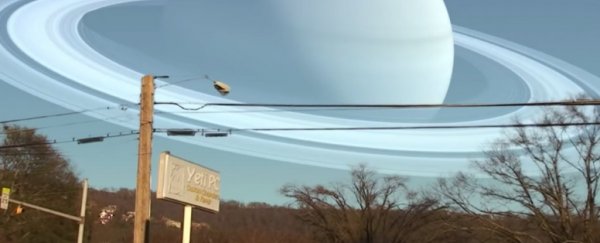You're not going to wake up one morning to see Jupiter hanging in the sky, but two stunning animations show what it would look like if you did.
Nicholas Holmes, an amateur astronomer, makes videos about space on his YouTube channel, Yeti Dynamics.
One of his creations, which has gone viral a few times since he published it in 2013, shows what it would look like if the planets in our Solar System orbited Earth at the Moon's distance.
A second video depicts the same scenario – a parade of planets looming in the sky above a city street – as it would look at night.
"I wanted to see what it would look like," Holmes told Business Insider in an email. "My primary drive is to settle my own curiosity."
So he took some video of the sky in Huntsville, Alabama, and swapped the Moon for other planets using 3ds Max software. The animations below are the result.
If other planets replaced our Moon
James O'Donoghue, a planetary scientist who works at Japan's space agency, JAXA, said the sizes of the planets in the video were accurate.
"I checked the maths!" he tweeted in October.
If you look closely in the video, you can spot Jupiter's four big moons: Io, Europa, Ganymede, and Callisto. When Saturn takes its place, the moon Tethys glides past its rings.
You might notice one planet missing from the video: Mercury. That's because it's barely larger than Earth's Moon, with a 1,516-mile (2,439 km) radius. Jupiter, on the other hand, is the largest planet in the Solar System, at 88,846 miles wide. Saturn appears even more dramatic because of its rings, which add 350,000 miles to its diameter.
Holmes also made a night-time version of the scenario. This video shows the rings around Uranus, and Saturn's moon Dione also makes an appearance, orbiting Saturn at about the same distance as our Moon. Of course, that means Dione would likely collide with Earth in the scenario depicted in the animation.
Holmes also suggested a DIY way to roughly re-create how big these planets would appear if they hung in the sky at the Moon's distance.
"A simple demonstration is to hold out a dime at arm's length. That's about the diameter of the Moon," Holmes said. "If you hold out a dinner plate, that's about the size of Jupiter. Maybe it doesn't take up the 'entire sky,' but it's pretty darn big."
If big planets like Jupiter were close to Earth, it would lead to volcanic destruction
Not everything in Holmes' videos is accurate, however.
First, the amount of sunlight shining on the planets is "slightly off from reality," he said, to make details clearer. The planets aren't tilted to exactly the right degree, and they aren't rotating at the correct speeds.
Of course, if the planets got that close to Earth, the whole scene wouldn't proceed as calmly as it appears in Holmes' video.
If Jupiter, Saturn, Uranus, or Neptune appeared in the Moon's place, Earth itself would become one of that planet's moons.
To see what that would mean for us, we just have to look at Jupiter's moon, Io.
Tidal forces from Jupiter stretch and compress Io – similar to how our Moon makes Earth's ocean tides, which change by up to 60 feet (18 metres). But Jupiter's huge mass stretches and compresses Io so much that its rock surface bulges back and forth by up to 330 feet.
Two of Jupiter's other moons, Ganymede and Europa, also contribute to the tug-of-war with their own gravitational pulls on Io.
All that tugging heats up the tiny moon and builds pressure in the hot liquid below its surface, leading to volcanic eruptions so powerful that lava shoots directly into space. The tidal forces make Io the most volcanically active body in the Solar System.
"We could expect a similar scenario on Earth. Initially, Earth's mantle and crust would be gravitationally attracted to Jupiter and break apart like crème brûlée," O'Donoghue told Business Insider in an email.
"Volcanic activity on Earth would be the stuff of a disaster movie, and overall, Jupiter would make light work of Earth."
This article was originally published by Business Insider.
More from Business Insider:
